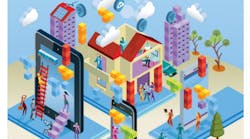Get connected: The phrase is everywhere. Go to any industry conference or attend a new product launch, and chances are you will hear all about the benefits of connecting products and systems to the Internet and its potential to change life as we know it. From your kitchen to the factory floor, it seems that enterprising minds can see the potential for simplifying our work and daily lives by implementing systems that can anticipate our needs and save us precious time—all by virtue of connecting to a World Wide Web that allows us to store, access, and share information.
But despite the promise of the Internet of Things market—or as it is variably called, “the Internet of Everything” and even “the Internet of Stuff”—questions linger surrounding its potential as a game-changer for the electronics supply chain. In the near-term, for one thing, IoT has a way to go before it is a household word. It remains largely the domain of engineers, technology companies, electronics manufacturers, and the like. That means the supply chain has work to do to impress upon the general public their need for IoT solutions, some industry watchers say. Then there are the issues of privacy and security. With the sharing of so much information comes the potential for a backlash against how open our lives have become.
“I think the IoT debate needs to be framed in wider terms,” says Christian DeFeo, e-supplier manager for electronics distributor element14. He points to the data available simply by talking on your smartphone—it tells where you are, what the temperature is in the room, and other seemingly benign facts, for example. “It used to be that people felt secure about this. But big data allows analysis of this information … As a society, we haven’t had a debate about what constitutes security and privacy [in this new era].”
DeFeo and others argue that the promise of the IoT market—great though it is—will depend largely on how well companies work together to make sound decisions about how to best use the technology. Distributors and their channel partners play a key role in this process by helping customers filter through the many new products available, along with their technological capabilities and applications.
DeFeo points to the element14 online community—a forum that consists of upwards of 280,000 engineers worldwide—as one way to do this. In addition to being a forum to discuss ideas, issues, and challenges, the community also offers webinars and design challenges aimed at helping design engineers and others discover the newest and best ways to implement IoT technology. He also notes that partnerships with technology company Cisco and The Eclipse Foundation, a non-profit organization that promotes development of open-source software, are helping to build a collaborative approach that will benefit the industry as a whole down the road.
“As a responsible and forward-thinking distributor, we want to give people as much information as possible so they make the best possible decisions,” DeFeo says. “We will continue to work with our community of engineers to get them to think about these issues in ways that will help [promote] reasonable decision-making and secure applications development.”
Building Momentum
For Robin Gray, chief operating officer and general counsel of the Electronic Components Industry Association, there is still a ways to go before widespread adoption of IoT solutions takes hold and, consequently, before it takes off for the electronics supply chain. ECIA devoted its most recent industry conference to the “Living Connected” theme, examining the influence of IoT, the Cloud, smart devices, and wearable technology.
“We’ve talked about the Internet of Things over the past years, but I don’t think that concept has really crossed into the broad public’s awareness,” Gray says, pointing to the need for industry to answer the “why” about this new technology and create demand for new products. “There is this gap between what the industry knows about what’s happening and what’s going to happen, and what public awareness is.”
Wearable technology and a heightened demand for sensors is a more immediate and growing trend, he adds.
“I think wearable technology is a bigger thing—and some think of it as a subset of IoT,” Gray explains, pointing to demand for monitors and sensors needed for such products.
Distributors are most concerned about the components designers demand for their newest products, and Gray says if ECIA’s conference was any indication, sensors are it today. Indeed, demand for sensors is expected to rise significantly over the next several years. Industry expert Dr. Janus Bryzek told ECIA conference attendees that sensors for wearable devices alone grew by more than 200% from 2007 to 2012. What’s more, industry analyst IHS Technology has predicted that sensor sales will rise more sharply than device sales themselves over the next five years. IHS also said in a report late last year that the average wearable device shipped in 2019 will incorporate an average 4.1 sensors, up from an average of 1.4 sensors in 2013.
“If I was in the audience and I was a distributor, I’d make sure I was getting into or expanding my sensor lines,” Gray says. “That was definitely the takeaway.”
Some would argue that making the leap from sensors and wearables to larger “connected” systems such as factories, homes, and transportation systems is not so far off. Element14’s DeFeo agrees that the connected marketplace—and the Internet of Things in particular—holds great promise for the electronics supply chain.
“For distributors like ourselves it’s an enormous opportunity,” he says, pointing to industry estimates that peg the market in the trillions of dollars. “The way that you’re going to get there is by embedding electronics into a lot more things than they are in today. That’s a lot of silicon. That’s a lot of boards. It’s a lot of kits and development boards.”
Safety and Security
But there is work to do before the IoT opportunity is fully realized, and DeFeo points to safety and security as two key hurdles. The pervasiveness of Internet technology and the accompanying openness the public is susceptible to because of it could just as easily become a turn-off. Consumers, especially, could end up opting for simpler, less invasive devices.
“There are good, solid economic reasons to adopt [this technology], but if enough people feel like they’re sharing too much, the momentum will stall and stop,” DeFeo says. “There are wider implications of sharing all this data.”
If the creators of Internet-enabled products and systems aren’t careful about making the right decisions, De Feo says the technology could “founder on the rocks of people’s objections.”
And that’s because the IoT, in particular, is less about sensors and other components connecting machines to one another than it is about better, more efficient decision-making, DeFeo says. He uses a small design engineer in Europe as a case in point. The designer created an alarm clock that ties into the Belgian railway system timetable to wake users according to when they need to arrive at their destination—rather than waking them to a specific, pre-set time.
On a larger scale, such technology can be used to streamline supply chains and make more efficient use of raw materials that go into factories, for example. Or it could be used for energy-saving applications in cities and towns. Despite the considerable talk about smart thermostats, refrigerators, and entertainment systems, there is much more to this technology revolution than home automation, DeFeo argues. He points to an element14 design challenge, in conjunction with Cisco, to develop IoT-enabled pollution sensors, as another example.
“There is a wider implication for the economy in terms of energy usage, industrial production, and so on,” DeFeo says. “Home automation is just the start.”










